Most teams agree that learning is key to reducing risk. But not all learning happens during implementation. And not all approaches to product discovery are as iterative as we like to think.
In many orgs, there’s a tendency to treat product discovery and design work as a way to front-load certainty. Research gets packaged into polished prototypes. User flows are vetted, click-through demos reviewed, copy finalized. Boxes have been checked, sign offs are obtained, success feels inevitable. By the time development begins, there’s a sense that the hard part—the learning—is done.
From there, teams move into delivery mode. They build incrementally, they iterate on implementation, they follow agile rhythms. But the product thinking has already solidified. What gets built may be sliced small, but the underlying decisions are no longer being questioned.
It creates the comfort of “knowing” while giving the appearance of agility.
But it’s not agility. It’s choreography.
And when things shift—as they inevitably do—it becomes clear how little room we left ourselves to adapt.
Certainty Feels Safe. Learning Is Safer.
When we invest heavily in up-front discovery, it can feel like we’ve reduced risk. We’ve anticipated edge cases, validated with users, aligned on a vision. But that confidence is only real if we keep validating as we go.
No matter how thorough your discovery process is, the most reliable learning still happens where software meets customer. Early. Often. In context.
The further discovery is from that point of contact, the more assumptions sneak in. The tighter the prototype, the harder it is to change course. And the longer we go without user feedback on the live experience, the more fragile our work becomes—no matter how good it looked in design reviews.
Treat Discovery Like Delivery
The healthiest product teams don’t just iterate on implementation. They iterate on understanding.
They approach product discovery the same way they approach development: in small, testable steps. They release early prototypes not just to stakeholders, but to real users. They fold learning from production back into their product thinking. They augment initial discovery learnings with live product analytics, customer feedback, and satisfaction surveys (to name a few) as input to adjust and improve on what they've delivered. And they keep discovery going through delivery—not just before it.
This is what continuous discovery looks like. Not a separate phase, but an ongoing practice.
Instead of trying to eliminate risk through “getting it right,” they reduce risk by learning faster and adjusting sooner.
Make the Learning Loop Short
The teams that adapt best are the ones with the shortest feedback loops. They don’t pretend to be certain—they design their work so they don’t have to be.
They test assumptions quickly. They validate throughout the development and delivery cycle, not just after launch. They expect their early thinking to evolve. And because they’ve built that expectation into how they work, change doesn’t feel like failure—it feels like progress.
What’s Next
If your product process feels stuck—if discovery happens all at once and delivery happens in isolation—it’s worth asking: when was the last time we changed our minds?
Not because we were wrong. But because we learned something new.

